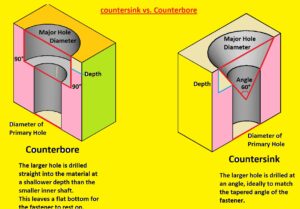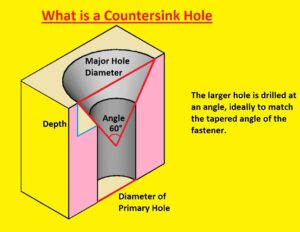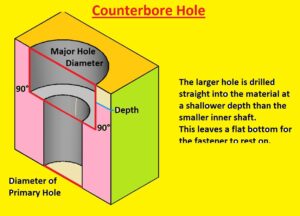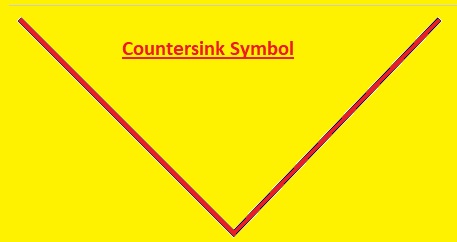 Hello guys welcome to the new post. In this post, we will discuss What is Countersink vs. Counterbore Holes in Machining. Shaping and cutting of materials like polymers and wood in differnt shapes is called machining. Drilling holes in machining used for assembly of differnt parts. COuntersink and counterbore holes are two drilling types. These two are machining techniques with different applications. This post will explain what countersink and counterbore holes are and how they vary. So let us start with Counterbore vs Countersink.
Hello guys welcome to the new post. In this post, we will discuss What is Countersink vs. Counterbore Holes in Machining. Shaping and cutting of materials like polymers and wood in differnt shapes is called machining. Drilling holes in machining used for assembly of differnt parts. COuntersink and counterbore holes are two drilling types. These two are machining techniques with different applications. This post will explain what countersink and counterbore holes are and how they vary. So let us start with Counterbore vs Countersink.
What is a Countersunk Hole?
- A countersunk hole is a cone-shaped hole made of material. The countersunk holes use flate head screws to make with materials without projecting. This process designs uniform surfaces which is good for manufacturing. Countersink holes can created at different angles and depths according to uses

What is Countersink Symbol
The countersink symbol is a graphical denotation used to position and parameters of countersink holes on technical drawings. It is a circle that comes with a diagonal line about it with a line denoting the countersink angle. With that dia of hole countersink depth can also shown in symbol
A countersink symbol, for example, will be as
This symbol indicates that countersink holes come with a diagonal angle of about 90 degrees required at the point in the figure. The countersink symbol is best for offering accuracy in the machining process.
Types of Countersink Holes
- have two main types single angle and multi-angle. Multi-angle countersink holes come with different angles while single angle countersink holes have one cone-shaped angle. Multi-angle countersink holes are made correctly.
Applications of Countersink Holes
- it is used for the creation of furniture, cabinets, and other woodwork. They are used in aviation and automobile uses that need accuracy
Advantages of Countersink Holes
- They create a smooth and level surface, which enhances the appearance of the object. These holes make strong connections by screwing the materials. Reduces wear and tear on screws and materials and increases object life
What is a Counterbore Hole?
- it is a circular, flat-bottomed hole drilled into materials. The counterbore hole operates to help bolt or screw heat with components of materials. It makes a flat surface that is best for object operation. Different depths can be created of counterbore according to the uses

Counterbore Hole Callout
- Countebore hole callout is a method to show certain featues of countebore hole. Dia and depth of hole are also other features shown in the callout. The callout is normally used on design with symbolic representation with measurement and other details on the table. The counterbore hole callout symbol is like a circle having a vertical line over it making it like a cylinder
- A counterbore hole callout looks like the CB 1/2″ x 1/4″ deep, which means a counterbore hole comes with 1/2 inch, and a depth of 1/4 inch is required. it is important for engineers to review and understand counterbore hole callouts before starting operation, make sure that the hole is made with correct features, and fulfill the needs of the required applications.
Types of Counterbore Holes
- Standard Counterbore Hole: It is a common type of counterbore hole and offers areas for bolt or screw heating. Its main featues are a flat bottom and a larger dia than a fastening head.
- Tapered Counterbore Hole: It has a tapered bottom that helps to use larger-size fasteners. The upper diameter of the hole is less than the lower part diameter.
- Spotfaced Hole: It offers a level surface about the fastener’s head. it comes with a flate bottom and the dia is larger than the fastener’s head, it is larger than the conventional counterbore hole.
- Stepped Counterbore Hole: it comes in differnt sizes. It is used in mechanical assembly to have different fastener shapes
- Combination Counterbore Hole: it comes with a counterbore and countersink hole. It is used to make simple areas for the fastener head while producing a smooth, completed layout on the surface of the material.
Applications of Counterbore Holes
- it is used to make different instruments, engines, and other mechanical components. it is used in automobile and aviation due to having smooth surfaces, and uniform layout that make a strong joint and reduces wear and strain
Advantages of Counterbore Holes
Its advantages are listed here
- The flate surface is made with counterbore holes that increase the look of the final product.
- it makes a strong connection by making a bolt or screw head with the material.
- It also helps to use bolt or screw having larger heads that can increase device functions
Differences Between Countersink and Counterbore Holes
| Feature | Countersink | Counterbore |
|---|---|---|
| Shape | Cone-shaped | Cylindrical flat-bottomed |
| Size | Typically used for wood screws and metal screws | Typically used for larger fasteners such as lag bolts |
| Drilling angle | 120°, 110°, 100°, 90°, 82°, 60° | N/A |
| Callout symbol | ⌵ | ⌴ |
| Applications | Woodworking, printed circuit boards (PCB), sheet metal, and plastic | Machinery, construction, and automotive applications |

Countersink vs Counterbore Holes
- counterbore vs countersink details are given here
| Feature | Countersink | Counterbore |
|---|---|---|
| Shape | Conical | Cylindrical |
| Depth | Generally less | Deeper |
| Holding strength | Sufficient | Stronger |
| Best for | PCB, woodworking, plastic, thin sheet metal, etc. | Heavy-duty applications such as automotive, machinery, construction, etc. |
| Symbol | ⌵ | ⌴ |
| Cutting tool | Countersunk or countersink bit | Counterboring tool, end mill, or flat drill |
| When to use | For printed circuit boards where space is at a premium | When you want to create a socket feature that needs to connect with strength and durability to last |
| Spotface | Similar to a counterbore in geometry, but with less depth | Done to clean the uneven or curved surface to provide a flat seating surface for the screw head |
| Depth of spotface | 1/32” to 1/16-inches (approximately 1 to 1.5mm) | Equal to the thickness of the washer |
Factors to Consider When Choosing Between Countersink and Counterbore Holes
- The selection of the hole type can be affected by the material with the use of a drill. Such as wood works well for countersunk holes, and metal works use counterbored holes.
- The type of screw or bolt also affects the use of a hole. Such as countersink holes used for flat-head screws and counterbore holes used for larger-headed bolts and screws
- it looks important then use holes that are uniform and smooth surface
- it makes strong and helps to choose hole type tha provdies strong connection joint
How to Drill Countersink and Counterbore Holes
The drill bit is used for the operation to make countersink or counterbore holes. These bits are in cylinder shape as the tip comes with a larger dia than other components
- Use an accurate drill bit
- Mark mid-of-hole
- Drill hole to required depth
- Clean any rough edges
Tips for Drilling Countersink and Counterbore Holes
- Depth steps make sure regular depth
- Press drill used for high accuracy
- Backing board for avoiding splintering
- Lubricant reduces heat and increases drill bit life
Common Mistakes to Avoid When Drilling Countersink and Counterbore Holes
- Using the wrong drill bit
- Using too much force.
- Drilling too deep.
- Not using a backing board
- Not using a lubricant
When should counterbore be used?
- The counterbore is used to increase the opening hole generating flat bottom so the socket head screw will correctly fit flush with part of the surface. Lock washers can be used to ensure strong assembly
What is the purpose of a countersink?
- A countersink is used to create conical shape holes in materials normally metal wood or plastic, so screws, bolts and other fasteners can connect to surface
- A fastener’s head can connect below the surface of material when it is connected in countersunk hole have a smooth surface. It can be used in fields like furniture creation that need larger holes
- Countersinking comes with advantages to protect materials and is faster from any damage.
- The angle for countersink is between 60 and 120 degrees. The right angle varies on the base of the size and fastener used. The countersink bit is an example of hand tills used to countersink.
What are the advantages of countersinking?
- The countersink makes a flush finish between the fastener and the surface of the material, which can be good for the look is a consideration.
- The fastener’s head tha is made over the surface of the material can interfere with parts of the structure or cause snag chances. It can be removed through a countersink that reaches the fastener head on the surface.
- head of the fastener head comes with a larger surface for the countersink can make a stable connection. For considering stress or vibration it can be important
- .With that this process increases the functions of assembly. Parts can move easily having less friction through removing interference and making a smooth surface, which increases performance..
- Countersink is used to make it compatible with other parts or components in larger assembly.
What are the purposes of thru counterbore and countersink hole types?
Thru counterbore:
- For making holes having flat bottoms that can get bolts or screws and finished flush through tightening down below the surface of the material.
- use a fastener having a larger diameter or providing high space for the fastening head.
- To avoid interfering with another component
Countersink:
- To cut a conical notch in the material surface in the resulting fastener head with another flush surface.
- Eliminating protruding fastener heads helps joints or connections become good
- To decrease snagging chances on protruding fastener heads
- Increases surface area for fastener headrests to increase the stability of the connection.
- Enhances overall operation by making pieces move without resistance
What is a Countersink used for?
It is used to make depression so that screws, bolts, or other fasteners can flush with the surface. The reduction of any protruding fastener heads make joint good
The certain drill bit made for cutting conical shapes can used to make countersiks. The size and type of fastener used will define the size and the angle of the countersink.
The main benefit of using Conuntesink is it reduces interference due to fastener heads that stick out. Protruding fasteners are easily used and can be important in conditions where the material is a chance to vibrate..
Conclusion
Important machining processes like countersink and counterbore holes are employed to increase the appearance and strong connection in mechanical systems. These two are different and are used on the base of material type, screw or bolt type, look, and strength also considered. Countersink and counterbore holes can be made according to speed to the use of the right instruments and techniques and generate quality product
FAQs
- Write the difference between countersink and counterbore holes.
- The countersink is cone-like a hole, and the counterbore is a cylinder flat-bottomed hole that is made on a socket or hex head cap screw. In simple words countersink hole is cone-shaped while a counterbore hole is cylindrical.
- Which hole type should be used for wood?
- For wood, countersink holes used
- Which hole type can be used for metal?
- For metal, counterbore holes are used
- What type of drill bit should I use to drill countersink or counterbore holes?
- Use a drill bit that is made for counterboring or countersinking.
- What are some common mistakes to avoid when drilling countersinks or counterbore holes?
- Drilling too deeply, using the incorrect drill bit, not using a backing board or lubricant, applying high force, and removing and rough edges are all examples of common errors.






